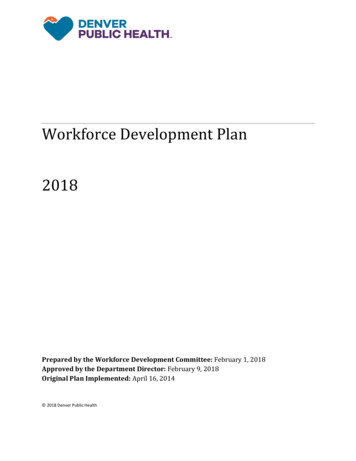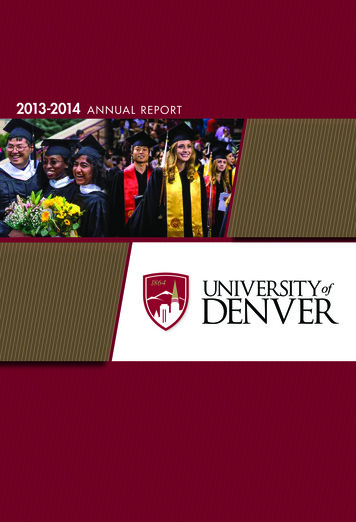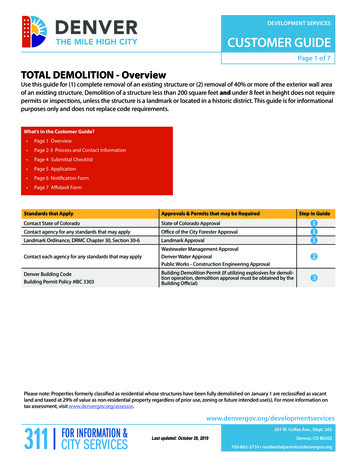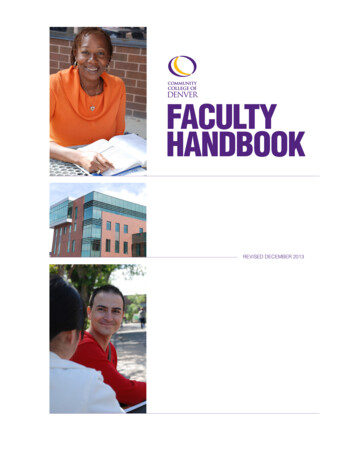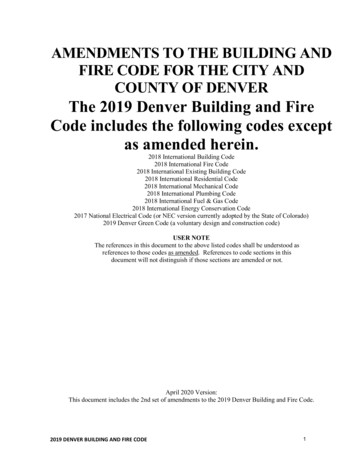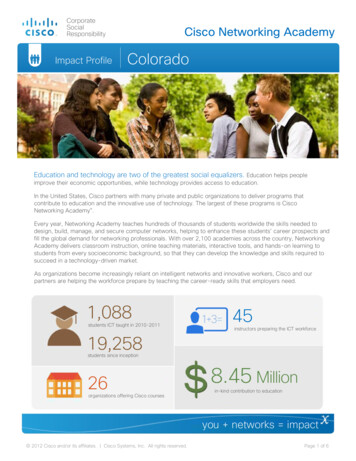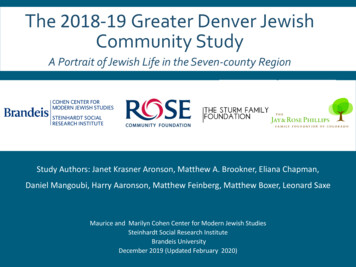
Transcription
The 2018-19 Greater Denver JewishCommunity StudyA Portrait of Jewish Life in the Seven-county RegionStudy Authors: Janet Krasner Aronson, Matthew A. Brookner, Eliana Chapman,Daniel Mangoubi, Harry Aaronson, Matthew Feinberg, Matthew Boxer, Leonard SaxeMaurice and Marilyn Cohen Center for Modern Jewish StudiesSteinhardt Social Research InstituteBrandeis UniversityDecember 2019 (Updated February 2020)
AcknowledgmentsFrom Rose Community FoundationSupporting OrganizationsThe 2018-2019 Greater Denver Jewish Community Study: A Portrait ofJewish Life in the Seven-county Region was funded with support fromRose Community Foundation, the Jay & Rose Phillips Family Foundationof Colorado and the Sturm Family Foundation.Thank you to the following organizations for supporting the study:Thank you to the research team at the Maurice and Marilyn CohenCenter for Modern Jewish Studies (CMJS) and the Steinhardt SocialResearch Institute (SSRI) at Brandeis University. Thank you to FranSimon of Simon Analytics, Inc., for her ongoing assistance with the study.The project design was developed with guidance from advisorycommittee members Judy Altenberg, Josh Gold, Rob Klugman,Dr. Laurence Kotler-Berkowitz, Julie Shaffer, Dr. David Shneer, Rabbi JayStrear and Emily Sturm. Early research for the study began in 2017 andwas led by Bruce Phillips, Professor of Sociology and Jewish CommunalService at Hebrew Union College, Los Angeles, and Dan Lainer-Vos,Adjunct Professor of Sociology at the University of California, LosAngeles. Shere Kahn was the project manager for the first phase ofwork, in partnership with Lisa Farber Miller, who oversaw it in herformer role as Rose Community Foundation’s senior program officer forJewish Life. Adventure Rabbi: A SynagogueWithout Walls Beth Jacob High School ofDenver Birthright Bnai Havurah: Denver JewishReconstructionist Congregation Boulder JCC Chabad of NW Metro Denver Colorado Jewish ProfessionalWomen Congregation Har HaShemDenver Jewish Day SchoolHazonHebrew Educational AllianceHillel AcademyJewish Explorers (a program ofJEWISHColorado) JEWISHColoradoJudaism Your WayKavod Senior LifeKeshet national LGBTQorganization Kohelet MazelTogether Rocky Mountain JewishHistorical Society and BeckArchives Staenberg- Loup JCC Temple Emanuel The Jewish Life Center:Chabad North Denver West Side Jew Crew (WSJC)The study was made possible by the Jewish community members whoparticipated in this project.2018-2019 GREATER DENVER AREA JEWISH COMMUNITY STUDY2
AcknowledgmentsFrom Cohen Center for Modern Jewish Studies and Steinhardt Social Research InstituteThe Brandeis research team is grateful to Rose Community Foundation, the Jay & Rose Phillips Family Foundationof Colorado, and the Sturm Family Foundation for the opportunity to collaborate and conduct the 2018-2019Greater Denver Jewish Community study. We are particularly grateful for the partnership and guidance ofVanessa Bernier, program officer at Rose Community Foundation, Fran Simon, president and founder of SimonAnalytics, Inc., and Shere Kahn, project manager for the first phase. We appreciate the support of Bruce Phillipsand Dan Lainer-Vos. Most of all, we thank the 2,507 respondents who completed the survey. Without theirwillingness to spend time answering numerous questions about their lives, there could be no study.The Siena College Research Institute served as the call center for this study. We are grateful for the efforts ofLeslie Foster, who acted as our main point of contact. Meghan Crawford and Marissa Bieber programmed theinstrument, administered the survey, and worked on the deliverables. We would also like to thank the manycallers who collected data from respondents.We are also appreciative of a large team of our colleagues and students at Brandeis University who assisted uswith the study. Sasha Volodarsky helped clean and analyze the data. Elizabeth Tighe, Raquel Magidin de Kramer,and Daniel Parmer led the efforts to develop an estimate of the adult Jewish-by-religion population of GreaterDenver as part of the Steinhardt Institute’s American Jewish Population Project. Masha Sud Lokshin edited andprepared the layout of the report. 2019 Brandeis UniversityLast updated February 27, 2020Maurice and Marilyn Cohen Center for Modern Jewish Studieswww.brandeis.edu/cmjs2018-2019 GREATER DENVER AREA JEWISH COMMUNITY STUDY3
Exec SummaryReport ContentsIntroduction and Overview.5Findings . 6Demographics . . . 6Jewish Life, Synagogues, and Jewish Education . 11Jewish Communal Life . .18Philanthropy and Volunteering . 25Intermarried Families . . 34Grandparents and Extended Families . . 39Economics and Health . . 41Study Methodology . . 472018-2019 GREATER DENVER AREA JEWISH COMMUNITY STUDY4
Introduction and OverviewThe 2018-19 Greater Denver Area Jewish Community Study, conducted by the Maurice and Marilyn Cohen Center for ModernJewish Studies (CMJS) and the Steinhardt Social Research Institute (SSRI) at Brandeis University, employed innovative state-ofthe-art methods to create a comprehensive portrait of the characteristics, attitudes, and behaviors of present-day GreaterDenver Jewry. The study focuses on the Jewish community in Adams, Arapahoe, Boulder, Broomfield, Denver, Douglas, andJefferson Counties.A sample survey of 2,507 Jewish households conducted in August-December 2018 and continued in June-July 2019 form thebasis of the study findings. More information about survey methodology is summarized on the last page of this report anddescribed in detail in a technical appendix.Unless otherwise specified, this report presents weighted survey data in the form of percentages or proportions. Accordingly,these data should be read not as the percentage or proportion of respondents who answered each question in a given way, butas the percentage or proportion of the population that it is estimated would answer each question in that way had eachmember of the population been surveyed. No estimate should be considered an exact measurement. Differences of less than 10percentage points should be treated with caution. The reported estimate for any value, known as a “point estimate,” is themost likely value for the variable in question for the entire population, given available data, but it is possible that the true valueis slightly lower or slightly higher.In some tables, not all response options are shown. For example, a table may show the proportion of a group who participatedin a Passover seder, but the proportion who did not participate in the seder will not appear. When a percentage is between 0%and 0.5% and would otherwise round down to 0%, the number is denoted as 1%. When there are insufficient respondents in aparticular subgroup for reporting reliable information, the estimate is shown as “—“.To provide context for interpretation of results, we sometimes provide relevant comparisons to the national Jewish population.Data on the US Jewish population is drawn from the Pew Research Center’s 2013 A Portrait of Jewish Americans.1 Comparisonsto Western Jews are drawn from the same study but are limited to Jews who live in the states of Arizona, Colorado, Idaho,Montana, Nevada, New Mexico, Utah, Wyoming, Alaska, California, Hawaii, Oregon, and Washington. Although these analysesare informative, due to differences in methodology and question wording, comparisons across studies are not as reliable as thedata from the present study.1 Lugo,L., Cooperman, A., Smith, G. A., O’Connell, E., & Sandra, S. (2013). A portrait of Jewish Americans: Findings from a Pew Research Center survey ofUS Jews. Washington, DC: Pew Research Center.2018-2019 GREATER DENVER AREA JEWISH COMMUNITY STUDY5
Demographics2018-2019 GREATER DENVER AREA JEWISH COMMUNITY STUDY6
Greater NaplesPopulationJewish PopulationEstimatesGreater Denver 2019 Population EstimatesThe Greater Denver Area Jewish community includes anestimated 90,800 Jewish individuals residing in 51,100households. Jewish households contain 134,900 individualsand include both Jewish and non-Jewish adults and children.Total JewsFor purposes of this study, the following definitions are used:People in Jewish households 90,800134,900Jewish adults are those who consider themselves to beJewish in any way (including Jewish and another religion)AND have at least one Jewish parent, or were raisedJewish, or converted to Judaism.Jewish householdsJewish children are children of at least one Jewish parentbeing raised Jewish in any way (including Jewish andanother religion).- Jewish adults72,900- Non-Jewish adults36,500- Jewish children17,900Jewish households are defined as households in whichat least one Jewish adult resides. HH is used anabbreviation for households in report tables and alwaysrefers to Jewish households. People in Jewish households include all individuals whoreside in Jewish households, regardless of their religion. Children are under age 18, unless otherwise specified. Adults are ages 18 and above.51,100People in Jewish households include:- Non-Jewish children7,500Note: throughout this report, be aware that no estimateshould be considered an exact measurement. Differencesof less than 10 percentage points should be treated withcaution.2018-2019 GREATER DENVER AREA JEWISH COMMUNITY STUDY7
Geographic DistributionThe largest shares of Greater Denver Jewish householdsreside in Denver (29%) and Boulder (26%).Distribution of Greater Denver Jewish population by regionPeople 222627North & WestMetro20271921South Metro16151917Aurora5455North & EastMetro48441001001001002018-2019 GREATER DENVER AREA JEWISH COMMUNITY STUDY8
Geographic DistributionDistribution of Jewish population within DenverDistribution of Jewish population within BoulderThis map represents the distribution of theapproximately 14,500 Jewish households in Denver. Eachdot represents 50 households, placed randomly withinthe zip code in which those households are located.2018-2019 GREATER DENVER AREA JEWISH COMMUNITY STUDYThis map represents the distribution of the approximately13,000 Jewish households in Boulder. Each dot represents50 households, placed randomly within the zip code inwhich those households are located.9
Community DemographicsThe age distribution of the Greater Denver Jewishcommunity is similar to that of Jews nationally andJews in the Western U.S.Household CompositionAge DistributionRoommates / Other3%Adult livingalone16%Adult childrenand parents14%Age18-3435-4950-6465-7475 Adults withminorchildren29%Couple livingalone39%The largest share of households (39%) iscomposed of a couple either married orpartnered and without children. The nextlargest share (29%) are households with oneor more children under age 18.2018-2019 GREATER DENVER AREA JEWISH COMMUNITY STUDYGreater DenverJewish adults (%)272328157U.S. Jewishadults (%)282030129Western U.S.Jewish adults (%)252334116Other demographic characteristics: Gender and sexual orientation: 49% of Jewish adultsare male and 51% are female. Less than 1% of Jewishadults are transgender or have another genderidentity. 6% of Jewish adults identify as LGBQ. Racial and ethnic identity: 10% of Jewish adults saytheir race is something other than white, and/or thatthey are Hispanic/Latino Country of origin: 3% of Jewish adults were born inIsrael or have a parent who was born in Israel. 9% ofJewish adults were born in the Former Soviet Unionand/or raised in a Russian-speaking household.10
Jewish Life, Synagogues, andJewish Education2018-2019 GREATER DENVER AREA JEWISH COMMUNITY STUDY11
Jewish Denomination and MarriageJewishdenominational identificationNearly half of Jewish adults do not identify with a specific Jewish denominationNearly half of Jewish adults are married to someone who is not JewishNearlyhalf (46%) of Jewish adults do not identify with aspecific Jewish denomination. This rate is similar toJews in the West (42%) but higher than the nationalrate of 30%.Four-in-five Jewish adults are married or have a partnerwith whom they live. Among these married orpartnered Jewish adults, 59% have a non-Jewish spouseor partner. This rate is similar to Jews in the West, ofwhom 60% have a non-Jewish spouse, but higher thanthe national rate of 44%.Jewishadults (%)U.S. Jewishadults (%)Western U.S.Jewish adults (%)Orthodox382Chabad 1Conservative121814Reform283535Other ewal3Other1No denomination46Cultural or Secular25None21Marriage and intermarriage2018-2019 GREATER DENVER AREA JEWISH COMMUNITY STUDYJewishadults (%)Jewishhouseholds (%)Not married or partnered2024Inmarried3320Intermarried475612
Typology of Jewish EngagementWe identified five distinct patterns of Jewishbehavior among the Jews of the Greater DenverJewish community. This typology is based on astatistical analysis of many dimensions of Jewishbehavior:rituallife, communallife,ofculturalIndexof Jewishengagement:Diverse patternsengaging life,inJewishlifeand personallife. The index provides a lens forunderstanding Jewish life that is moreinformative than an analysis based ondenominational identification.The engagement groups are based on the typesof Jewish activities that members of thecommunity do most frequently. The largestgroups are the Holiday, with Jewish engagementprimarily centered around holiday celebrations,and the Communal, which in addition to holidayobservance, is notable for its attendance atcommunity programs, volunteering, anddonations to Jewish organizations.2018-2019 GREATER DENVER AREA JEWISH COMMUNITY STUDY13
Activities Used to Determine Jewish EngagementProportion of individuals engaging in Jewish activity for each engagement groupMinimallyInvolved (%)Personal(%)13Jewish adults (%)Holiday(%)12Communal(%)27Immersed(%)2918Family holidaysAttended sederCelebrate Shabbat or holidaysLight Shabbat 44725003390874881718696100Organizations and programs (past year)Attend program at JCCAttend program/service at ChabadAttend program/service at a synagogueDonated to Jewish organizationVolunteered for Jewish organizationParticipate with Jewish social action groupAttend Jewish educational programJewish congregationsPay dues to congregationAttend services at least monthlyPersonal activities (past year)Visited Jewish websitesRead Jewish publicationsLegend0-1920-3940-592018-2019 GREATER DENVER AREA JEWISH COMMUNITY STUDY60-79A set of 14behaviors acrossmultipledimensions wereused to determinethe Jewishengagementtypologies.This table showsthe proportion ofJewish adultswithin each groupwho participatedin each behavior.For example, 98%of Immersed andCommunal Jewsattended aPassover seder,compared to 11%of MinimallyInvolved Jews.80-10014
Demographics and Jewish EngagementMinimallyInvolved (%)Personal (%)Overall13Age518-341435-49Indexof Jewish engagement: Diverse patterns of engaging inJewishlife2250-64965-791475 Gender12Male15FemaleRegion14Denver10South Metro12Boulder15N&W Metro19Aurora7N&E MetroMarital status12Unmarried13MarriedFinancial status12Well off13Not well offHoliday (%)Communal (%)Immersed (%)Total -2019 GREATER DENVER AREA JEWISH COMMUNITY STUDYDemographics ofthe engagementgroups vary. Forexample, Thelargest shares ofJews in Denver arein the Communal(26%) andImmersed (31%)groups, but thelargest shares ofJews in Boulderare in the Holiday(27%) andCommunal (29%)groups.15
Jewish Background and Jewish EngagementMinimallyInvolved (%)Personal (%)Overall13DenominationOrthodox 1Conservative8Index of Jewish engagement: Diverse patterns of engaging inReform5JewishlifeOther15None20Marital status (of married)InmarriedIntermarriedParentsParents inmarriedParents intermarried orconvertedChildhood Jewish EducationJewish educationNo Jewish educationHoliday (%)Communal (%)Immersed (%)Total (%)12272918100 12171312233630222214100100Denominational labels do not capture the full range of Jewish engagement. Among the Orthodox, 83% are Immersed, but Jews of alldenominations (including none) are part of the Immersed group.2018-2019 GREATER DENVER AREA JEWISH COMMUNITY STUDY16
Synagogue Membership and Participation Sixteen percent of households include a dues-payingsynagogue member. Twenty percent of Jewish adults live in a household inwhich someone is a dues-paying synagogue member. In the U.S. West, 27% of Jewish adults live in ahousehold with a synagogue member. Nationally, 38%of Jewish adults live in a household in which someoneis a synagogue member. Twenty-eight percent of Jewish adults never attendJewish religious services. Ten percent attend once amonth or more.Frequency of attending Jewish religious servicesJewish adults (%)Once a week or more4Once or twice a month6A few times a year30Seldom31Never282018-2019 GREATER DENVER AREA JEWISH COMMUNITY STUDYJewish households that include a dues-paying synagoguememberSynagogue members (%)Jewish households16Engagement groupMinimally 4950-6465-7475 RegionDenverSouth MetroBoulderNorth & West MetroAuroraNorth & East Metro01124726151921251922128272117
Jewish HolidaysCelebrated Shabbat Attended Seder Ever lit Shabbat candlesor holiday (%)(%)(%)All ObservanceJewish adults76of selected Jewish holidaysEngagement groupMinimally ge18-348335-498150-646865-746975 76RegionDenver77South Metro78Boulder79North & West Metro67Aurora66North & East Metro78Marital statusInmarried93Intermarried65Not 17771656163915139363545649355656527422018-2019 GREATER DENVER AREA JEWISH COMMUNITY STUDY Three-in-four Jewish adults in GreaterDenver marked Shabbat or a holiday insome way in the last year; 70%attended a Seder. Participation in these holidaycelebrations is highest among theImmersed group and rare among theMinimally Involved. Inmarried families have much higherrates of holiday celebrations than dointermarried families.18
Attitudes about Being Jewish Comparing attitudes about being Jewish is one way to illustrate the differences among the engagement groups. Almostnine-out-of-ten (87%) Immersed Jews indicate that being Jewish is very important to them, compared to only 8% ofMinimally Involved Jews. All groups, however, share the belief that acceptance of all people is an essential aspect of beingJewish. Among all Jewish adults, 22% report that they have personally experienced antisemitism in the past year, 67% have not,and 11% are unsure.Importanceof BeingJewishToleranceimportantto being JewishFor nearlyall Jewishadults,being accepting of all people is essentialtoisJewishidentityAll Jewish adultsMinimally InvolvedPersonalHolidayCommunalImmersed2% 11%11%4%47%39%25%29%55%61%36%1% 11%1%Minimally Involved37%39%1% 14%3%8%56%21%All Jewish adults3%12%85%97%1% %16%80%89%92%87%Not at all importantNot very importantSomewhat importantVery importantQuestion: “How important is being Jewish for you?”2018-2019 GREATER DENVER AREA JEWISH COMMUNITY STUDYNot importantImportant but not essentialEssentialQuestion: “How important to what being Jewish means to you Being accepting of all people, regardless of their race or religion?”19
Jewish EducationJewish households with age-eligible Jewish children whohave at least one child in each form of Jewish education Seven percent of Jewish children are enrolled inJewish preschool. This represents 500 Jewishchildren.7% of Jewish children in Jewish ECE28% of K-12JewishchildrenJewishformal Twenty-eightpercentof ageeligibleinK-12Jewisheducationchildrenare enrolled in Jewish formaleducation, with 21% in part-time school(Hebrew school, Sunday school, or religiousschool), and 7% in day school. There are an estimated 2,200 Jewish childrenenrolled in Jewish part-time school, and 900Jewish children enrolled in Jewish day school. Participation in all forms of Jewish education ishigher among inmarried families thanintermarried families.Households with ageeligible Jewish children(%)Engagement groupMinimally rSouth MetroBoulderNorth & West MetroAuroraNorth & East MetroMarital statusInmarriedIntermarriedNot married2018-2019 GREATER DENVER AREA JEWISH COMMUNITY STUDYPreschoolPart-timeDay 0283452136--28151720 1520
Jewish Communal Life2018-2019 GREATER DENVER AREA JEWISH COMMUNITY STUDY21
7 in 10 feel it is important to be connected to a local Jewish communityJewishCommunityFewer than Connectionshalf feel connectedtoto anyJewish community Seven-in-ten Jewish adults feel it is important to be connected to a local Jewish community. Sixty-eight percent of the Immersedfeel that the connection to a local Jewish community is essential to being Jewish. Among Communal Jews, one quarter (24%) feelthis connection is essential, and two thirds (65%) believe it is very important. Of the Minimally Involved, Personal, and HolidayJews, almost none think that a connection to the local Jewish community is essential to being Jewish. Less than half of Jewish adults feel connected to ANY Jewish community, and just over half feel disconnected. Among theImmersed, 54% feel very connected to the Jewish community, and 39% feel somewhat connected. Among the Communal, 60%feel at least somewhat connected to the Jewish community.Local Jewish community is important to being JewishAll Jewish adultsMinimally InvolvedPersonalHoliday30%74%50%Feeling connected to Jewish communityAll Jewish adults21%Minimally Involved26%49%49%40%2%57%3%ImmersedNot important11%2%65%31%Important, not munal28%26%29%32%5%16% 1%38%9%28%31%Immersed14%1% 6%52%2%8%39%54%68%EssentialQuestion: “How important to what being Jewish means to you Beingpart of your local Jewish community where you live?”2018-2019 GREATER DENVER AREA JEWISH COMMUNITY STUDYVery disconnectedSomewhat disconnectedSomewhat connectedVery connectedQuestion: “Generally speaking, how connected do you feel to any type ofJewish community right now?”22
Disconnection from Jewish CommunityReasons for feeling disconnected from any Jewish communityFeelsdisconnectedfrom any Jewishcommunity(%)Among those disconnected from Jewish community, % who gave this as a reason (select all that apply) (%)Notrelevant toyour liferight now(%)Do not haveenough time(%)Do not feelthat youbelong (%)526148393321201514Minimally 41410199North & orth & 373425982110221981915131318All Jewish adults (%)Do not feel Do not want to Uncomfortable withGeographicallyyou knowexclude nonthe connectionisolated fromenough about Jewish friendsbetween beingthe Jewishbeing Jewish and/or partnersJewish and Israelcommunity (%)(%)(%)(%)Do not feelthat youwould bewelcomed(%)Engagement groupAge18-3435-4950-6465-7475 RegionDenverSouth MetroBoulderMarital statusInmarriedIntermarriedNot marriedOver half ofJewish adultsfeel somewhator verydisconnectedfrom any Jewishcommunity.Except for theoldest Jewishadults (age 75 ),younger andolder adults aresimilar in theirlevel ofconnection toJewishcommunity.Among thosedisconnectedfrom Jewish life,the top reasonwas lack ofrelevance.Question text: Generally speaking, how connected do you feel to any type of Jewish community right now? Very connected, somewhat connected, somewhatdisconnected, very disconnected. [If somewhat/very disconnected:] Which explain why you feel disconnected from the Jewish community? You 2018-2019 GREATER DENVER AREA JEWISH COMMUNITY STUDY23
Participation in Jewish Community InstitutionsAttended program or service at three Jewish institutions in past year:Synagogue (%)JCC (%)All Jewish adults6140Engagement groupMinimally Involved032Personal Attended Program or Service at selected Jewish24Institutions in past 73035-49635150-64584565-74573175 5341RegionDenver6950South Metro5927Boulder5952North & West Metro5124Aurora6029North & East Metro7543Marital statusInmarried8050Intermarried4534Not married6839Chabad (%)1502102329192110108 Although only 20% of Jewish adults livein a household in which someone is adues-paying synagogue member, 61%of Jewish adults attended a program orevent at a synagogue in the past year. Forty percent of Jewish adults attendeda JCC program, and 15% attended aChabad program. Minimally Involved Jews attendprograms at the JCC more than at anyother institution.151616121124181119Note: Question was asked only about these three organizations. Participation in otherorganizations was not measured in the survey.2018-2019 GREATER DENVER AREA JEWISH COMMUNITY STUDY24
Participation in General ActivitiesGeneral activity and program participation, at least 2-3 times per monthExplore newrestaurants (%)Exercise Attend cultural Host dinnerclass/group (%) productions (%) parties (%)General Activity and Program Participation, at least 2-3 timesAll Jewish adults7753 per monthEngagement 15165-74655075 8350RegionDenver8158South Metro7354Boulder8657North & West7349MetroAurora7536North & East7753MetroMarital statusInmarried7254Intermarried8253Not married8255Meditate(%)Adult ed.class 24455503118302018-2019 GREATER DENVER AREA JEWISH COMMUNITY STUDYJewish adults regularlyparticipate in a wide variety ofsocial and cultural activities.Seventy-seven percent explorenew restaurants two to threetimes per month. This is themost frequent activity for allages and engagement groups.25
Participation in Jewish ActivitiesParticipation in Jewish activities, ever in past yearAll Jewish adultsEngagement groupJoined aRead aboutJewishVisited Jewish Took Jewish Activities, past yeartopics(%)group (%)31248063Used Jewishdating app (ifsingle) (%)10Minimally -3435-4950-6465-7475 RegionDenverSouth MetroBoulderNorth & West MetroAuroraNorth & East MetroMarital statusInmarriedIntermarriedNot 683735760471838361527n/an/a102018-2019 GREATER DENVER AREA JEWISH COMMUNITY STUDYJewish adults participate in arange of Jewish activities. Themost common were those that donot involve a group ororganization, such as readingabout Jewish topics (80%) andvisiting a Jewish website (63%). Amuch smaller share took a Jewishclass (31%) or joined a Jewishsocial action group (24%).These patterns held for Jewishadults of all ages and across allregions.Among the Immersed Jews,nearly all read about Jewishtopics, visited a Jewish website,and took a Jewish class.26
Attachment to Israel Over half (55%) of Jewish adults have been to Israel. Eight-in-ten Jewish adults feel that caring about Israel is important to being Jewish, including 33% who feel it is essential to beingJewish. About half of the Immersed and the Communal consider Israel as essential to being Jewish, as do one quarter of thePersonal and Holiday Jews. Over half (58%) of Jewish adults feel at least somewhat attached to Israel and another quarter (26%) feel not very attached. Only16% of Jewish adults are not at all attached Israel.Emotional attachment to IsraelCaring about Israel is important to being JewishAll Jewish adultsMinimally dNot important33%47%20%59%55%12%5%41%38%Important, not essentialAll Jewish adults25%33%26%16%More than half of Jewish adults feel attached to Israel, and 80% consider Israel important to being Jewish55% of Jewish adults have been to Israel at least once.Minimally Involved4%28%37%33%22%25%47%57%EssentialQuestion: “How important to what being Jewish means to you Caring about Israel?”2018-2019 GREATER DENVER AREA JEWISH COMMUNITY STUDYPersonal21%HolidayCommunalImmersed 2%Not at all ot very attached1%Somewhat attachedVery attachedQuestion: “How emotionally attached are you to Israel?”27
Philanthropy and Volunteering2018-2019 GREATER DENVER AREA JEWISH COMMUNITY STUDY28
Jewish Charitable DonationsDonations to Jewish charity in past yearAll Jewish householdsEngagement groupMinimally 4950-6465-7475 Standard of living(Self-reported)Well-offNot well-offRegionDenverSouth MetroBoulderNorth & West MetroAuroraNorth & East MetroMarital statusInmarriedIntermarriedNot marriedDonated toJewish charity(%)48Of donors, amount given (%) 100 100500 5001,000 1,0002,500 2,5005,000 5,000 723001061505082046444258544427912154230
Jewish Studies (CMJS) and the Steinhardt Social Research Institute (SSRI) at Brandeis University, employed innovative state-of-the-art methods to create a comprehensive portrait of the characteristics, attitudes, and behaviors of present-day Greater Denver Jewry.


